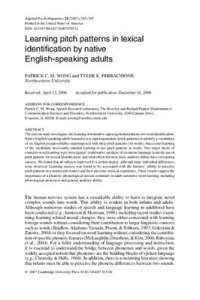
Ebook: Learning pitch patterns in lexical identification by native English-speaking adults
- Genre: Linguistics // Linguistics
- Tags: Языки и языкознание, Лингвистика, Фонетика и фонология
- Language: English
- pdf
Applied Psycholinguistics 28 (2007), 565–585.The current study investigates the learning of nonnative suprasegmental patterns for word identification.
Native English-speaking adults learned to use suprasegmentals (pitch patterns) to identify a vocabulary of six English pseudosyllables superimposed with three pitch patterns (18 words). Successful learning of the vocabulary necessarily entailed learning to use pitch patterns in words. Two major facets of sound-to-word learning were investigated: could native speakers of a nontone language learn the use of pitch patterns for lexical identification, and what effect did more basic auditory ability have on learning success. We found that all subjects improved to a certain degree, although large individual differences were observed. Learning success was found to be associated with the learners’ ability to perceive pitch patterns in a nonlexical context and their previous musical experience. These results suggest the importance of a phonetic–phonological–lexical continuity in adult nonnative word learning, including phonological awareness and general auditory ability.
Native English-speaking adults learned to use suprasegmentals (pitch patterns) to identify a vocabulary of six English pseudosyllables superimposed with three pitch patterns (18 words). Successful learning of the vocabulary necessarily entailed learning to use pitch patterns in words. Two major facets of sound-to-word learning were investigated: could native speakers of a nontone language learn the use of pitch patterns for lexical identification, and what effect did more basic auditory ability have on learning success. We found that all subjects improved to a certain degree, although large individual differences were observed. Learning success was found to be associated with the learners’ ability to perceive pitch patterns in a nonlexical context and their previous musical experience. These results suggest the importance of a phonetic–phonological–lexical continuity in adult nonnative word learning, including phonological awareness and general auditory ability.
Download the book Learning pitch patterns in lexical identification by native English-speaking adults for free or read online
Continue reading on any device:

Last viewed books
Related books
{related-news}
Comments (0)